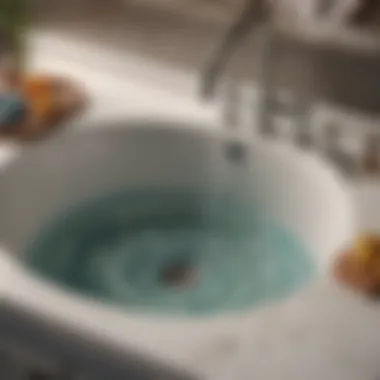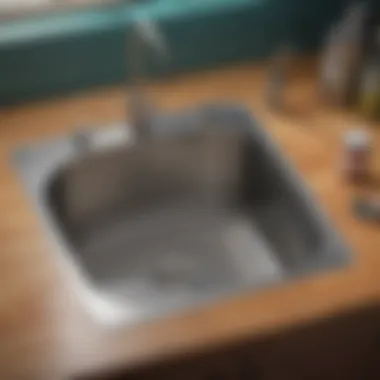Resolving Sink Clogs: Garbage Disposal Insights


Intro
A sink clogged with garbage disposal issues can create significant inconveniences. Understanding the underlying causes of such clogs is essential for their effective resolution. Garbage disposals, while innovative appliances, can be prone to a variety of mechanical failures and user-related problems. This article will outline the key aspects of dealing with clogs, from common causes to practical solutions and preventative measures. We will also touch upon the importance of maintenance and working with professionals when necessary, aiming to keep your kitchen functional and aesthetically pleasing.
Architectural Inspiration
Overview of Design Styles
Incorporating a garbage disposal into kitchen design can impact the overall aesthetic. Many contemporary kitchens embrace open-plan designs, making the disposal's location crucial. Traditional and modern styles may require a different approach to placement and visibility. For example, a farmhouse kitchen might conceal the garbage disposal to maintain its vintage charm, while a sleek, modern kitchen may showcase it as part of a minimalist design.
Innovative Materials and Techniques
The choice of materials in kitchen design affects both functionality and visual appeal. Stainless steel is commonly used for garbage disposals due to its durability and resistance to corrosion. Integrating sound-dampening insulation can also enhance user experience by reducing noise. Adopting innovative plumbing solutions, such as food waste recycling systems, is becoming more popular. These systems not only improve function but also align with sustainable living practices, appealing to environmentally conscious homeowners.
Understanding Common Causes of Clogs
Identifying the root causes of clogs is vital to finding a solution. Here are some common factors:
- Food Residue: Large food particles can easily jam the mechanisms of a garbage disposal.
- Grease Build-up: Grease can solidify in the pipes, leading to significant blockages.
- Foreign Objects: Non-food items inadvertently entering the disposal can cause a malfunction.
Signs of a Clogged Sink
Recognizing the signs of a clog early can prevent more severe issues. Look for:
- Slow drainage
- Unpleasant odors
- Gurgling sounds in the drain
Effective Methods for Resolution
Quick Fixes at Home
- Plunge the Sink: Use a plunger to create pressure and dislodge minor clogs.
- Baking Soda and Vinegar: Pour a mixture down the sink and let it sit. Rinse with hot water afterward.
- Check the Disposal: Ensure the disposal is running properly and free of jams.
When to Call a Professional
Sometimes, a problem may require professional help. Consider contacting a plumber for:
- Persistent clogs that do not clear with home remedies.
- Strange noises from the disposal that suggest mechanical failure.
- Signs of leaks under the sink.
"Being proactive with maintenance can save you time and money in the long run."
Maintenance Tips
Regular maintenance can prevent many common issues:
- Run Water: Always run cold water when using the disposal to facilitate waste breakdown.
- Clean Regularly: Periodically clean the disposal with citrus peels or ice cubes to keep it fresh.
- Avoid Certain Foods: Stay away from fibrous vegetables and starchy foods that can lead to clogs.
By understanding the dynamics of kitchen sinks and garbage disposals, homeowners can maintain a functional and stylish kitchen. A solid approach to preventing and resolving clogs will help ensure your space remains both practical and visually appealing.
Prologue to Garbage Disposals
Garbage disposals play a crucial role in modern kitchens. These devices offer convenience and efficiency in managing food waste, making them an essential part of household plumbing systems. They simplify the disposal process, help maintain cleanliness, and reduce odors in the kitchen.
The key benefits of garbage disposals include their ability to minimize waste in landfills and promote sustainable practices. By grinding food scraps into smaller particles, disposals facilitate easier disposal through plumbing systems, reducing the volume of waste sent to landfills. This not only aids in waste management but also contributes to environmental sustainability.


When considering the topic of garbage disposals, it is vital to understand their functionality and the common types available on the market. Homeowners should also be aware of the maintenance requirements to keep these devices operating effectively and to prevent issues such as clogs, which can disrupt kitchen activities.
The Functionality of Garbage Disposals
Garbage disposals function through a simple mechanism. When food waste is placed in the disposal unit, it is ground down by rotating blades, often referred to as impellers. This pulverization process turns waste into a slurry that can easily flow through pipes into the sewage system. The disposal is usually connected to the sink drain and is activated by a switch, generally located near the sink.
Typically powered by electricity, these devices operate silently while efficiently disposing of organic waste. Regular use helps to keep sewage systems clear, and proper operation can enhance the effectiveness of household plumbing.
Common Types of Garbage Disposals
There are generally two main types of garbage disposals:
- Continuous feed disposals: These units allow for waste to be fed continuously as long as the disposal is running. They are convenient for busy kitchens and can handle large quantities of waste quickly.
- Batch feed disposals: This type requires the user to load food waste into the disposal and then cover it with a lid before operation. This model is safer as it helps to prevent objects from accidentally falling in during operation.
Additionally, manufacturers offer various horsepowers, usually ranging from 1/2 horsepower to 1 horsepower. Higher horsepower models can handle more substantial waste and function more efficiently.
Tip: Choose a garbage disposal unit based on your kitchen size, frequency of use, and types of food waste typically generated.
Understanding these basic elements of garbage disposals sets the foundation for addressing any issues that may arise, particularly clogs that can hinder their operation.
Understanding Clogs in a Sink
Understanding clogs in a sink is vital for homeowners and design enthusiasts alike. A clogged sink can disrupt daily routines and create inconveniences, especially when it occurs in the kitchen where waste is commonly disposed. Recognizing the root causes and signs of clogs not only saves time but also helps in maintaining a functional and aesthetically pleasing kitchen environment. In this section, we will delve into the primary factors that lead to sink clogs and how to identify them effectively, ensuring that you can act proactively to prevent such issues from escalting.
What Causes a Sink to Clog?
Several factors contribute to sinks becoming clogged. One major cause is food waste that is improperly disposed of through the garbage disposal. When larger pieces of food are sent down the drain, they can create blockages in the pipes. This is particularly true for fibrous foods, such as celery or potato peels, which do not break down easily.
Mineral build-up from hard water is another significant contributor to clogged sinks. As minerals like calcium accumulate over time, they can restrict the flow of water, creating a backlog. Grease and oil from cooking can also contribute to clogs. When grease cools, it solidifies and can adhere to the sides of pipes, causing further obstruction.
Furthermore, foreign objects accidentally falling into the sink can lead to serious clogging issues. These items can create blockages directly, or they may catch food particles, further compounding the issue. Regularly inspecting drains can help in identifying potential problems early.
Recognizing Signs of a Clogged Sink
Recognizing the signs of a clogged sink early is crucial in addressing the problem before it worsens. Some common indicators include:
- Slow draining water: If water pools in the sink or drains very slowly, it often signals an underlying clog.
- Unpleasant odors: Foul smells arising from the sink often suggest decomposing food particles caught in the disposal or pipe.
- Gurgling sounds: If you hear gurgling noises when you turn on the faucet, it can indicate air trapped by a clog, creating a vacuum effect.
- Backflow: Water backing up into the sink can be a clear sign that a serious clog is present.
Being aware of these signs can empower homeowners and design enthusiasts to take action quickly. Early intervention is key to preventing more extensive issues and costly repairs.
The Role of Garbage Disposal in Clogs
Garbage disposals serve an essential role in modern kitchens, transforming food waste into small particles that can easily flow down the drain. However, they can also be a significant contributor to sink clogs. Understanding this relationship between garbage disposals and clogs is crucial for effective kitchen management.
When functioning properly, a garbage disposal can enhance the efficiency of waste disposal and maintain a cleaner kitchen environment. Yet, improper use or maintenance issues can lead to clogged sinks, disrupting daily activities. Households face greater challenges when a clog engulfs their plumbing system, leading to potential property damage and costly repairs. It is important to comprehend how disposals contribute to these issues and which materials are likely to cause clogs.
How Garbage Disposals Contribute to Clogging
Garbage disposals help manage waste but can inadvertently contribute to clogging due to several key factors.
- Overloading the Disposal: Filling the disposal with too much food at once can prevent effective grinding, leading to larger particles being washed down the drain. This accumulation can quickly result in clogs.
- Suboptimal Usage of Water: Not using enough water when operating the disposal can hinder food particles from fully breaking down, causing them to stick in the pipes.
- Type of Foods Processed: Certain foods are problematic for disposals. Fibrous vegetables like celery and large amounts of starchy foods like pasta can constrict the disposal, reducing its effectiveness and leading to blockages.
- Lack of Maintenance: A garbage disposals requires regular cleaning and maintenance to function optimally. Neglecting this can lead to residue build-up, affecting both the disposal and plumbing.
By recognizing these contributing factors, homeowners can take steps to minimize clogging, enabling the garbage disposal to work effectively while preventing sink issues.
Types of Materials That Cause Clogs


Certain materials are particularly notorious for causing clogs in garbage disposals. Understanding these can help in making informed decisions about what can safely go down your disposal.
- Fibrous Materials: Items like celery, asparagus, and corn husks can wrap around the disposal blades, causing them to jam.
- Starchy or Thick Foods: Foods such as mashed potatoes or pasta can expand when mixed with water, creating thick pastes that solidify and block pipes.
- Grease and Oil: Pouring fats down the drain, even in small amounts, can solidify in the pipes over time, creating serious clogs.
- Hard Objects: Bones, fruit pits, and coffee grounds can physically damage the disposal and lead to severe blockages in the plumbing.
It is crucial to understand which materials are suitable for disposal to maintain both your sink functionality and overall plumbing health.
In summary, being knowledgeable about the role of garbage disposals in clogs helps to navigate the challenges of kitchen management effectively. Regular awareness and maintenance can protect against clogs and enhance the lifespan and efficiency of your kitchen's disposal system.
Diagnosing the Clog
Diagnosing a clog in the sink is a critical aspect of addressing garbage disposal issues. It is not just about restoring the flow of water; it involves understanding the underlying problems that cause these disruptions. A precise diagnosis can save time and money. Without it, homeowners often resort to trial and error, leading to further complications.
The first step in diagnosing a clog involves observing the immediate symptoms. This includes noticing whether the water drains slowly, makes unusual noises, or if there is a foul smell coming from the disposal. Each of these signs can indicate different issues. Additionally, understanding the design of the sink and its plumbing can aid in identifying trouble spots. Knowing where potential blockages are likely to occur helps streamline the troubleshooting process.
Initial Observations and Tests
After identifying the symptoms, initial observations are crucial. Homeowners should start by checking the garbage disposal switch—ensuring it is working properly. If the disposal runs but does not clear waste effectively, it might be jammed. In such cases, removing the cover can allow for a visual inspection of the grind chamber.
Conducting a water test is also valuable. By filling the sink with water and quickly draining it, one can observe the speed of water flow. If it drains slowly or not at all, it confirms a blockage exists. Additionally, feeling for vibrations in the pipes can help determine if there is a serious clog or simply debris lodged in the system.
Further basic tests can include running the disposal with ice cubes or using a plunger to create a vacuum effect. These methods can sometimes dislodge minor blockages. However, these should be performed with caution to avoid damaging any components.
Advanced Diagnostic Techniques
In complex cases, advanced diagnostic techniques may be necessary to pinpoint the source of the clog. This could involve using a plumbing snake or an auger, which allows for deeper inspection into pipes. These tools can navigate around bends and reach further distances, often drawing out stubborn blockages.
Another method is the use of a camera inspection system. By inserting a small camera into the pipes, homeowners or professionals can view the inner workings of the plumbing. This detail enables a more sophisticated understanding of the problem, revealing not just clogs but also potential corrosion or structural issues within the pipes.
Moreover, checking the disposal’s drainage line for blockages is essential. This often involves disconnection of the line and a thorough inspection to ensure no debris obstructs the flow.
Applying these techniques can dramatically increase the odds of successfully diagnosing the clog and addressing it efficiently. Ignoring this step may lead to persistent problems, increasing the risk of damage to the disposal and plumbing system.
Resolving a Clogged Sink
Addressing sink clogs caused by garbage disposals is crucial for maintaining an efficient kitchen. Improper disposal practices can lead to significant plumbing issues, resulting in inconvenience and unexpected expenses. Understanding both DIY solutions and when to engage a professional is important for homeowners who want to maintain smooth functioning in their kitchens.
It requires an analytical approach to assess the specific situation, identifying what tools and methods may be effective. This section aims to provide a clear understanding of practical steps that can resolve clogs while also addressing the need for professional intervention when necessary.
DIY Solutions for Clogs
When faced with a clogged sink, there are several DIY methods that homeowners can implement. These solutions can often save time and money.
- Check the Garbage Disposal: If the disposal is running sluggishly, it may need to be reset or cleared. Turn off the device and check for any foreign objects or blockages.
- Use a Plunger: A plunger can effectively create pressure to dislodge a clog. Ensure there is enough water in the sink to cover the plunger's cup. Work vigorously, pushing and pulling until the sink drains properly.
- Baking Soda and Vinegar: This combination can break down debris causing the clog. Pour half a cup of baking soda followed by a cup of vinegar into the drain. Allow it to sit for about 15 minutes, then flush with hot water. This method is particularly effective for organic material.
- Plumbing Snake: If the clog remains, using a plumbing snake can help reach deeper blockages. Insert it into the drain, cranking it as you push it further down. This may require some patience.
- Hot Water: Pouring hot water down the drain can help dissolve fats and oils that may be contributing to the clog. This is a straightforward method and a good first step if the clog is minor.
"Regular maintenance can greatly reduce the likelihood of clogs forming in the first place."
Implementing these methods gives homeowners the opportunity to take control of minor issues without the need for costly service calls.
When to Call a Professional
While many clogs can be resolved with DIY methods, there are times when professional help is needed. Understanding these circumstances can prevent further complications:
- Persistent Clogs: If multiple attempts to unclog the sink fail, it may signify a more severe issue that requires a professional plumber.
- Frequent Backups: If sink backups occur regularly, it could indicate a deeper problem within the plumbing system.
- Strange Noises or Odors: Unusual sounds or strong odors during operation may indicate mechanical failures or deeper clogs that are beyond a homeowner's tools.
- Water Flow Issues: If other drains in the home are also slow to drain, it is a sign that there may be a more significant blockage in the main drain line.
- Lack of Tools or Experience: If a homeowner feels uncomfortable or lacks the appropriate tools to resolve the issue, calling a professional is always a wise decision.
Recognizing when to seek professional advice enables homeowners to make informed decisions, avoiding the potential for greater issues down the line.


Preventative Measures
Preventing issues related to garbage disposals and sink clogs is essential for maintaining the functionality of kitchen spaces. By adopting various preventative measures, homeowners can save on costly repairs and ensure a seamless flow in their daily routines. Awareness of good practices when using a garbage disposal, along with regular maintenance routines, plays a vital role in preventing clogs. Here, we explore the critical elements and benefits associated with these preventative strategies.
Regular Maintenance of Garbage Disposals
Routine maintenance of garbage disposals is one of the most effective ways to prevent clogs. Over time, food particles can accumulate inside the disposal, leading to obstructions. Regularly flushing the disposal with cold water while running it can help reduce buildup. Here are some steps to adopt:
- Run the Disposal Regularly: Operating the disposal at least once a week helps keep it functional. Even small amounts of food waste can help prevent stagnation.
- Use Cold Water: Cold water solidifies any grease or oils, allowing them to be chopped up effectively. This is important because warm water can liquefy these substances, leading to clogs in the pipes.
- Clean the Disposal: Periodically cleaning the disposal with ice cubes and rock salt can help eliminate odors and reduce buildup. This natural method is effective and keeps the mechanism sharp.
By following these practices, homeowners can enhance the lifespan of their garbage disposals and mitigate the risks of potential clogs.
Best Practices for Waste Disposal
Knowing what can and cannot be disposed of in a garbage disposal is crucial. Many homeowners may mistakenly believe that any food waste can go down the drain. However, certain items can lead to severe clogging issues. Here are some best practices:
- Avoid Fibrous Foods: Items such as celery, corn husks, and artichokes can tangle around the disposal blades, causing jams.
- No Grease: Pouring fats, oils, or grease down the sink can lead to solidified blockages in pipe systems.
- Small Portions: Disposing of food waste in small quantities allows the disposal to function more efficiently, reducing strain on the system.
- Soft Foods Only: Items like cooked potatoes or soft fruit peels can generally be processed without difficulty. Hard or tough foods should be avoided.
Implementing these waste disposal guidelines aids in minimizing the chances of experiencing clogs, contributing to a more effective and cleaner kitchen environment.
Regular attention to maintenance and informed disposal practices can prolong the life of your garbage disposal and maintain plumbing efficiency.
Impact of Clogging on Home Design
The issue of sink clogging, particularly when associated with garbage disposal systems, extends beyond mere inconvenience. It can significantly influence the overall design and functionality of a kitchen. Homeowners and designers alike must recognize the importance of addressing clogs, as they directly impact both the aesthetic and functional elements of home environments. The relationship between plumbing systems and kitchen design is often overlooked, yet it is crucial for creating spaces that are both visually appealing and operationally efficient.
Understanding the impact of clogs allows for informed decisions about material selection, layout planning, and appliance placement within the kitchen. By recognizing the connection between plumbing issues and design elements, one can enhance the usability of the space while also maintaining a coherent aesthetic. In this section, we delve into two specific aspects of home design: Functional Aesthetics in Kitchens and Minimizing Clutter and Enhancing Flow.
Functional Aesthetics in Kitchens
Functional aesthetics blend beauty and practicality, particularly in kitchens where usability is paramount. An effective design manages to prioritize eye-pleasing elements while accommodating necessary appliances and plumbing fixtures. When garbage disposals are involved, the risk of clogs can challenge this balance.
To mitigate these challenges, homeowners should consider:
- Choosing Right Appliances: Select a garbage disposal with a reliable motor. High-quality disposals, like the Insinkerator Evolution series, are less likely to cause clogs compared to cheaper alternatives.
- Layout Configuration: Plan the kitchen layout to enable easy access to the disposal and sink areas. This promotes regular maintenance and quick responses to potential clogs.
- Material Selection: Use durable countertops and sinks that can withstand wear and tear from associated plumbing issues. Materials such as stainless steel or composite are often recommended.
By aligning design choices with functional requirements, one can create a kitchen that is both beautiful and practical, ultimately reducing the likelihood of clogs.
Minimizing Clutter and Enhancing Flow
Clutter in a kitchen not only detracts from visual appeal but can also obstruct smooth operation. A well-designed kitchen should support an efficient flow of activity, particularly in areas surrounding the sink and garbage disposal.
To enhance flow and reduce clutter in relation to sink clogs, consider these strategies:
- Organized Storage Solutions: Implement cabinetry and drawer systems that store most frequently used items close to the sink. This reduces the need for moving around the kitchen.
- Clear Pathways: Arrange appliances and fixtures to allow for easy navigation around the workspace. This is particularly important when dealing with plumbing issues, as quick access can prevent further complications.
- Regular Maintenance Schedule: Encourage a routine checkup for the disposal and sink systems. An organized approach to maintenance can significantly minimize future clogs, keeping the space functional and aesthetically pleasing.
Effective design in kitchens must account for practical issues such as clogging. Designers and homeowners can greatly benefit from integrating solutions that address performance without sacrificing style.
Ending
Summarizing Key Takeaways
- Recognizing Causes: The root causes of sink clogs often arise from improper disposal of materials, accumulation of food debris, and lack of regular maintenance. Being aware of what can go down the disposal is crucial for prevention.
- Signs of Trouble: Homeowners must watch for warning signs such as slow draining sinks, unusual sounds during disposal operation, and water backup. Early recognition can prevent further complications and enable quicker solutions.
- Resolution Strategies: Employing DIY solutions like using a plunger or cleaning the disposal with ice and salt can often resolve minor clogs. Knowledge on when to engage professional help is equally important to manage severe blockages effectively.
- Maintenance Importance: Regular maintenance routines, such as grinding food waste properly and cleaning the disposal periodically, can vastly reduce the likelihood of clogs.
- Impact on Design: Clogs not only disrupt functionality but can also influence the overall design and aesthetic of kitchen spaces. Well-thought-out plumbing design contributes to functional aesthetics.
Future Considerations for Homeowners
As technology evolves, homeowners should stay informed about advancements in garbage disposal systems. New models offer enhanced efficiency and safety features that could minimize clog occurrences. When considering home renovations or new builds, prioritize plumbing design alongside aesthetic choices to ensure functional flow.
Lastly, exploring more sustainable waste disposal options, such as composting, may provide an alternative to using disposals altogether. This shift can lead to better waste management practices and a cleaner environment.
By integrating these considerations and practices, homeowners can promote a harmonious balance between functionality and style in their kitchens.







